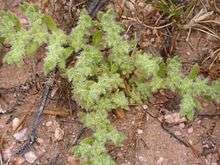Herniaria hirsuta
| Herniaria hirsuta | |
|---|---|
 | |
| Scientific classification | |
| Kingdom: | Plantae |
| (unranked): | Angiosperms |
| (unranked): | Eudicots |
| (unranked): | Core eudicots |
| Order: | Caryophyllales |
| Family: | Caryophyllaceae |
| Genus: | Herniaria |
| Species: | H. hirsuta |
| Binomial name | |
| Herniaria hirsuta L. | |
Herniaria hirsuta is a species of flowering plant in the pink family known by the common name hairy rupturewort.[1][2] It is native to Eurasia and North Africa, and it is known on other continents, including North America, as an introduced species. This is an annual herb with stems up to 20 centimeters long usually growing prostrate along the ground. The small, fuzzy, pale green leaves are up to about a centimeter long and coat the stems. The inflorescences appear in the leaf axils. Each contains 3 to 8 hairy green sepals and no petals. The fruit is a tiny bumpy utricle containing one seed.
This plant is used in Morocco as an herbal remedy for kidney stones.[3] Studies on rats demonstrate that extracts of the plant can prevent the deposition of calcium oxalate crystals in kidney tissue[3][4] by coating the crystals and stopping them from adhering to renal epithelial cells.[5]
References
- ↑ "BSBI List 2007". Botanical Society of Britain and Ireland. Archived from the original (xls) on 2015-02-25. Retrieved 2014-10-17.
- ↑ "Herniaria hirsuta". Natural Resources Conservation Service PLANTS Database. USDA. Retrieved 19 January 2016.
- 1 2 Atmani, F., et al. (2003). Prophylaxis of calcium oxalate stones by Herniaria hirsuta on experimentally induced nephrolithiasis in rats. British Journal of Urology International 92:1 137-40.
- ↑ Atmani, F. (2004). Effect of aqueous extract from Herniaria hirsuta L. on experimentally nephrolithiasic rats. Journal of Ethnopharmacology 95:1 87-93.
- ↑ Atmani, F. (2004). Extract from Herniaria hirsuta coats calcium oxalate monohydrate crystals and blocks their adhesion to renal epithelial cells. Journal of Urology 172:4 1510-14.
External links
| Wikimedia Commons has media related to Herniaria hirsuta. |